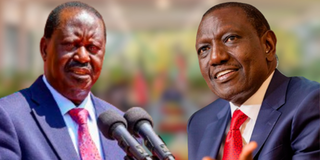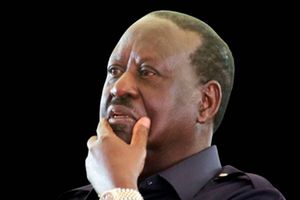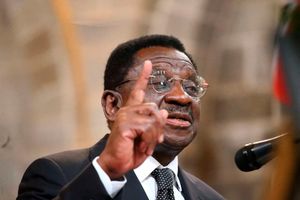
As Raila Odinga, 79, prepares to work with President William Ruto, he should be asked to re-read his father’s treatise, Not Yet Uhuru, lest he leaves his legacy at the doorsteps of Kenya Kwanza regime.
It was in 1967 that Jaramogi Oginga Odinga reminded us that “A government that is isolated from the people, because government and wealth are in the hands of an elite that is taking power to itself, will plunge our country into pain and tragedy.”
When Jaramogi wrote those words, he may have as well been referring to President William Ruto’s government, yet he was talking of Jomo Kenyatta’s government. Some 56 years later, nothing seems to have changed and the political elite are still applying survival tactics to retain power and wealth; both licit and illicit. Raila has been listening and un-listening. Of late, age appears to be catching up with him.
When his unauthorised biography is finally written, Raila will be portrayed as both a veteran of the trenches and a master of boardroom deals. He has dragged his friends and supporters into political battlefields, exposed them to drama, detentions, and into corridors of power. Sometimes he is a political acapella artist, and a lone ranger who takes advantage of his following to make unorthodox decisions. Right now, at a point where his relevance in politics had been challenged by Gen Zs, Raila has decided to ditch his Azimio la Umoja partners for a possible partnership with Ruto. His brother, Oburu Odinga, favours such an arrangement perhaps picking from their father who, when at political crossroads, opted to work with Moi much to the chagrin of Ford-Kenya members.
It is many years since Raila entered a similar working relationship with Moi’s Kanu to spite Democratic Party’s Mwai Kibaki and Social Democratic Party’s Charity Ngilu after the 1997 general elections. Shortly, Moi appointed him as Energy minister and Raila folded his party to become the Kanu secretary general in the hope that he would inherit Moi’s dictatorial machine. That was a surprise. But those were the days that he “bought” the government-owned Kisumu Molasses plant and brought in the controversial Energem Resources, the diamond dealers, as co-shareholders. Once upon a time, when I was a young Turk, these dealers came to Nairobi from South Africa to ask me where I got their papers after I broke the story. I think I told them off, which is a story I had previously narrated.
To cut the long story, Moi was looking for a younger generation comprising of Uhuru Kenyatta and William Ruto and that is how Odinga left with established Kanu elites to form a new bargaining platform – which the elite mask as political parties. With this platform, the ex-Kanu elites found space within Mwai Kibaki’s outfit where they crafted a Memorandum of Understanding (MOU) on how to share power within the National Rainbow Coalition (NARC). If you know the story, the elites could not agree among themselves on power sharing leading to its collapse in 2006. The elite disagreement was tribalised and led to the 2007 post-election violence. That is how the elites have played the tribal card since 1963.
The ongoing Gen Z uprisings have forced President Ruto and his elite circle into a challenging new landscape where the usual reliance on ethnic politics and patronage appears outdated and ineffective. These tactics, which belong to a bygone era and are now irrelevant, are being challenged. Caught between a rock and hard place, Raila's argument appears to emphasise the importance of political stability, suggesting that this can only be achieved if President Ruto's government remains in power until the next general election. He implies that any alternative, such as the resignation of Ruto and the subsequent succession by Deputy President Rigathi Gachagua, would not improve the situation and might even be equally undesirable. But in essence, Raila is worried of his elitisms.
To his Azimio fellows, Raila's willingness to collaborate with the Ruto regime seem both awkward and misinformed — unless, of course, he has been ensnared by Ruto's schemes to stabilise the dining table. They are also fighting for relevance and it is survival for the fittest now. Over the years, Raila has mastered the art of maintaining relevance, often employing the political strategy of "if you can't beat them, join them." This tactic, first used by Jomo Kenyatta to secure and solidify his leadership, has deep roots in Kenyan politics. Jomo, along with Raila’s father Jaramogi, persuaded members of the official opposition, Kadu, to leave their party and join his Kanu party. Gradually, Kadu members crossed the floor, draining the opposition swamp entirely.
The first to pay the price of that mischief was Jaramogi. He wrote, “I worked hard to have Kadu absorbed into Kanu; I hoped that an augmentation of strength would ginger up the party, and, most important, would end disunity and tensions among the people so that our united national energies could be harnessed in the building of the country.” Eventually, Jaramogi admitted, “I must admit that I calculated falsely; that the merger of KADU and Kanu, far from strengthening the party, introduced dangerously divisive policies and forces into Kanu and made possible the dilution of Kanu’s policy…”
The 1964 merger was a strategic alliance among elites who had reached a consensus on how to divide the national resources among themselves, setting aside the ethnic fears they had previously stirred up for political gain. This is what Ruto hopes to achieve, hoping he can short-circuit the Gen Zs ambitions and protect the elites.
In their book Oxford Handbook on Kenyan Politics, scholars Nick Cheeseman, Karuti Kanyinga, and Gabrielle Lynch describe Kenyan politics as a complex interaction among elites. They explain that when cross-ethnic elite relationships break down, ethnic tensions are unleashed until the elites re-establish working relations. For those familiar with Kenyan politics, it is evident that this elite cooperation has taken various forms over the years: single-party systems, power-sharing arrangements, coalition governments, governments of national unity, or what Ruto now calls a broad-based government. Raila entered into a similar handshake with Mwai Kibaki and later Uhuru Kenyatta. In the later, he rocked Jubilee from within – helping to create William Ruto as the subaltern candidate against established dynasties – or elites. Those who believed Ruto’s campaign trickery thought that the old elites would be banished.
As the three scholars argue, it is the “degree of elite cohesion” that determines Kenya’s political instability. Now, this long-standing yet unstable equilibrium is being disrupted by a non-ethnic Gen Z movement aiming to overhaul our politics from its ethnic foundations. It is a shift that has unsettled the status quo and alarmed the elites, who traditionally consolidate power through tribal networks – or what I could call stabilised instability. Third, the fear that the non-ethnic Gen Z might reboot our politics from its ethnic settings, has frightened the elites since we have a generation thinking of politics outside the logic of ethnic blocks.
What next?
At 79, Raila Odinga is a great-grandfather to the Gen Zs and while they recognize his contribution in the trenches, they think his time is up. Only those unfamiliar with Raila’s political manoeuvres would be surprised if he, or his lieutenants, finally finds space within President Ruto’s imagination of what constitutes a “broad-based Cabinet”. Should this happen, it would be a continuation of the age-old tradition of political elites uniting to safeguard their interests disguised as national unity. It is a survival strategy oiled by tribal configurations and self perpetuation. They are gimmicks that sustain elite brotherhood. That is why the more things change, the more they remain the same.
From 1963, Kenya is a terrain of different monkeys, same forest.









